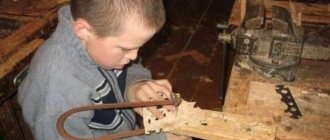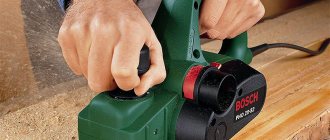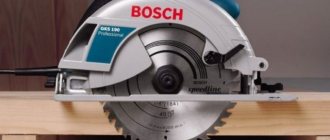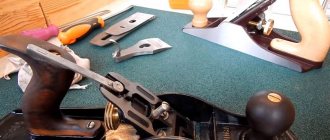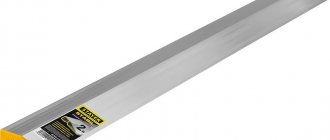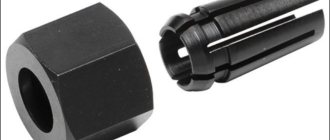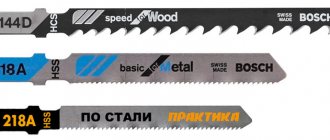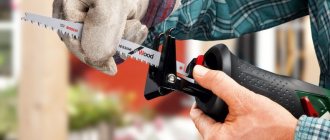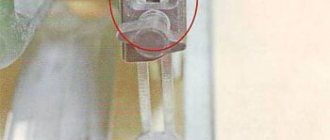Articles
All photos from the article
A jigsaw occupies an important place in the arsenal of any home-conscious person. With this tool you can work not only with wood, but also with plastic, tiles and even glass. Moreover, working with these materials is not limited to simple sawing; a jigsaw also allows creative individuals to show off their skills; you can even use it to do wood carving.
Jigsaw
Types of jigsaws
Formally, the principle of operation of a jigsaw is not far removed from a conventional saw - it is the same tool in which the blade makes reciprocating movements, due to which the cutting occurs. And yet, the purpose of a jigsaw is somewhat different from that of a simple saw.
If a regular saw is not intended for anything other than cutting thick and not very thick lumber, metal, plastic and other elements, then a manual jigsaw is used for finer work. With its help, you won’t be able to saw a 100x100 mm piece of wood, but you can make a shaped cut or saw a very thin sheet of wood without worrying about the quality of the cut.
In the photo - an ordinary manual jigsaw
Since the first appearance of the jigsaw on the market (and this happened back in 1946), manufacturers have been constantly adding useful improvements to its design, so now several types of the same tool can be distinguished:
- manual models are the simplest option. The design of such a jigsaw is extremely simple - a curved metal frame in the lower part of which a thin file is secured with 2 wings. This tool is suitable for small amounts of work;
Note! Using a hand jigsaw, you can make cuts literally with pinpoint precision. So, if you have no experience working with electric models, and the cutting line has a rather complex outline, then it is better to pay attention to manual models.
- jigsaw - in principle, everything is clear from the name; all that remains for a person to do is hold the device and make sure that the blade does not move away from the marked line. The vast majority of modern jigsaws for wood are electric, because due to the large number of vibrations of the blade, cutting takes much less time than using manual models;
Model powered by 220V mains
- It is worth highlighting the category of battery devices separately. They also belong to the group of jigsaws, but due to power from the built-in battery they have high autonomy.
Cordless jigsaw with rotary handle
Manufacturers try to think through the design of a jigsaw down to the smallest detail. For example, it can be connected to a vacuum cleaner so that sawdust does not clog the room; a lamp can be built into the body to illuminate the working surface. The jigsaw can also be equipped with a laser, which is needed to ensure that the file does not deviate from the marked line.
Jigsaw or saw
You need to understand that although jigsaws are used for the same purpose as saws, the result is still slightly different.
A band jigsaw has a number of advantages compared to a conventional saw:
- it gives a much smoother cut and in most cases you don't even need to sand it. But the cut from the saw turns out to be quite rough;
- Installing a file into a jigsaw is very simple; you don’t have to make a significant effort to do this. And you won’t have to adjust the canvas tension often;
- from a safety point of view, the saw is also inferior to a jigsaw;
- In terms of cost, the comparison is also not in its favor.
On the other hand, these tools solve different problems. A thin, elegant file is simply not able to cope with a thick piece of board or timber. If you try to make such a cut, then you can forget about accuracy - due to overheating, a decrease in the quality of the cut is inevitable. In addition, there is a high risk that the file will simply break, and the load on the engine will be higher than that for which it is designed.
A jigsaw can still handle this thickness
How to choose a jigsaw and files for it
Given the variety of models on the market, choosing the right option can be not so easy. In order not to make a mistake when choosing, you need to at least in general terms imagine the structure of a jigsaw.
The main components of a modern jigsaw
To understand the principle of operation, consider the structure of a regular household jigsaw.
Of course, depending on the manufacturer, the device of different models may differ, but in general the device remains the same:
- cutting regulator - modern models are equipped with it without fail. This is logical, because you can cut not only wood, but also plastic, aluminum and even steel. Instructions for cutting different materials require a different speed setting for each of them;
The device of a modern jigsaw
- multi-stage pendulum mechanism - it is used to ensure that the canvas oscillates not only in the vertical, but also in the horizontal plane. Thanks to this, the material is cut when the saw moves only in one direction; during the reverse stroke, the blade moves slightly back, thereby extending its life;
Pendulum mode can be disabled
- As a rule, in modern devices, files are not attached using screws or wings, but a special system is used to facilitate this process. Simply press the lever, remove the old one and insert the new blade;
- It will also be useful to be able to rotate the canvas around its axis by 360ᵒ. This is useful if you need to cut a round hole or any other closed contour. Instead of twisting your hand, you just need to turn the blade itself. Cutting out various patterns from wood with a jigsaw with a rotating blade is a pleasure;
- Sometimes it becomes necessary to make a cut at an angle. So the ability to fix the angle of inclination will also not be superfluous; the angle lock allows you to rigidly fix the angle in the range of 0-45ᵒ;
Angle lock allows you to make cuts at an angle
- the engine is cooled by a small fan, part of the air flow is directed directly to the cutting line, so that sawdust does not clog the markings and the line to be followed is always visible;
- The addition of a laser can significantly improve cutting accuracy. The laser beam is directed at the material being processed and when working, you just need to combine it with the markings; this is convenient if the view is partially blocked.
Laser beam improves the cutting accuracy of the workpiece
As for choosing a specific model, the main criterion can be considered cost. The fact is that household jigsaws can quite cope with lumber with a thickness of about 50-70 mm, as well as steel sheets up to 2-4 mm thick.
In most cases, this is more than a solution to all problems that arise during home renovation or construction, but such jigsaws cost 3 times less than professional models. The disadvantages include a shorter service life and a simpler design.
The number of blade vibrations per minute is also important. Most often, this indicator is in the range of up to 3000 vibrations/min; there are also more productive models, but their cost also increases.
Selection of files and operating rules
Jigsaw blades differ in many ways, including the material from which they are made, the type of fastening, the quality of the cut, etc. It can be difficult for a non-specialist to choose the appropriate option for their needs, so let’s look at the main types of files and their area of use.
Depending on the material being processed, the following files can be distinguished:
- for metal;
- wood;
- metal and wood;
- any other materials (in addition to plastic and foam plastic, steel, aluminum, tiles, etc. can also be cut).
Comparison of the design of a file for wood and metal (A and B) and a universal blade (C)
The design of the teeth greatly affects the quality of the cut:
- files for high-speed cutting have set, ground teeth. Due to this, the cutting speed is maximum;
- if the teeth are not set apart, the speed will decrease somewhat, but the edges of the cut will be without chips and perfectly smooth;
- Jigsaw blades for wood with wavy milled teeth are suitable only when the quality of the cut does not matter.
The shape of the tooth is of great importance. The fact is that blades with straight teeth are sawed in a top-to-bottom motion, but with reverse teeth, it’s the other way around. Therefore, when working with saws with reverse teeth, you need to fix the part, otherwise it may rise when the blade moves from bottom to top.
You also need to pay attention to the shape of the fastening; options with fastening in the form of the letter T or U are possible.
Types of shanks
In order to be guaranteed not to get confused, you just need to understand the markings of the canvases. Most questions will disappear on their own.
You need to pay attention to:
- color marker on the shank (white indicates that the blade is suitable for wood and metal, gray for wood, red for plastic, blue for metal, black for other materials);
- letter designation T or U, characterizing the method of fastening the canvas;
- the following number indicates the length of the blade (1 – no more than 75 mm, 2 – from 75 to 90 mm, 3 – from 90 to 150 mm, 7 – over 150 mm);
- the letters ABCD can be used to indicate tooth size;
- other letters are used to show the purpose of the file. F means that the file is bimetallic, O – intended for curved cutting, R – with a reverse tooth, P – blade of increased thickness (for cutting at an angle), X – the file is considered universal, HM – a high-strength alloy is used.
Examples of markings of some files
For example, the marking T101BIF means that a T-shaped fastening is used, the length of the blade is up to 75 mm, the tooth is small, the blade is bimetallic. Such a canvas can be used to very cleanly cut laminated chipboard and other capricious materials with your own hands.
How to choose a manual jigsaw for a schoolchild
When choosing a jigsaw for wood, you need to consider the following parameters:
- type of file;
- canvas size;
- design.
What files exist, which ones are suitable for starting and their classification
There are the following types of files for hand jigsaws:
- Standard or Standard tooth. These files are characterized by teeth that are the same size, distance from each other and direction.
- Reverse or Reverse Skip-tooth. Some of the cutters on the reverse saw are directed upward, which allows you to trim the material during the return movement of the tool. As a result, there are practically no chips on the reverse side.
- Files with missing teeth or Skip-tooth Blades. The absence of cutters eliminates the risk of jigsaw jamming and strong heating of the blade, promotes good removal of sawdust during the work process and increases processing speed.
- Files with double teeth or Double-tooth Blades. The main feature is getting a smooth cut. The file also removes chips well and heats up little.
The blades are distinguished by length, which affects the thickness of the material being processed. According to this parameter, canvas numbers are distinguished from 2.0 to 12.
Beginners, including schoolchildren, should pay attention to the characteristics of the blade when purchasing an instrument. Initially, it is recommended to work with a jigsaw measuring 130 mm, less often - 160 or 165 mm (blades number 3, 5, 7). The sawing thickness is 9.0-12.5 mm. For those who are just starting to saw wood, it is recommended to use saws with a high TPI value. Working with them is slower, but the cut is smoother and more accurate.
Types of models
If you plan to rarely work with woodworking tools, then choose simple models. Among them we can highlight the Stayer Master jigsaw, perfect for schoolchildren. Stainless steel files are durable and reliable. The model is designed for shaped cutting of wood and processing in hard-to-reach places.
Another good model is the Fit school jigsaw 41030. The frame and blade are made of tool steel. The wooden handle provides reliability and ease of grip.
If a student is interested in making products from wood or plywood, then it is recommended to purchase kits for cutting with a jigsaw. They are equipped with additional elements: clamps, stops, guides, etc.
When selecting models, you should pay attention to the manufacturer. You should not buy cheap tools made in China. They are characterized by low strength and short service life.
Design
The manual school jigsaw has a simple design. It consists of a metal frame, handle, file and clamps. The file is attached to the frame using drums or nuts. There is a handle on one side of the frame. It can be made of plastic or wood. The second option is more reliable and durable.
According to the shape of the frame, the tool can be rectangular or pointed. The first option is suitable for straight cutting of the material. The second type is used to create more complex lines.
Rules for working with a jigsaw
The quality of the cut and the service life of the file directly depend on the ability to use a jigsaw. For example, if you press hard on it, the blade will overheat and the quality of the ends of the workpiece will leave much to be desired. That is why you need to know the basic rules of working with this tool.
Basic recommendations
We can formulate several general rules that are suitable in all cases:
- dull files need to be changed, if this is not done, then the engine will have an additional load, and this is not entirely good;
- It is strictly forbidden to put pressure on the jigsaw in order to speed up the cutting process;
- you can use jigsaw templates for wood if you need to make a long cut and a complex configuration;
Several simple templates for cutting with a jigsaw
- You need to choose your own speed mode for each material. Wood, for example, should be cut at maximum speed;
Note! Plastic should be cut at a minimum speed; the fact is that with an increase in the number of vibrations of the blade, the edges of the plastic may simply melt.
- Under no circumstances should the element being processed be held with one hand and sawed with the other. In this case, you can forget about accuracy. The part must be fixed on the table, preferably with a clamp, so that it is guaranteed not to move;
- when working, it is recommended to turn on the pendulum mode when cutting along the fiber, this will reduce the risk of the blade moving to the side;
- It is better to cut close to the line, thanks to this there is no need to take into account the tolerance on the thickness of the cut when marking.
Carving with a jigsaw
This tool can be used not only for simple sawing of lumber, but also for creating spectacular patterns. For example, patterns on wood with a jigsaw for trims allow you to create a truly unique window design.
All you needed to make this beauty were boards, a stencil and a jigsaw.
Regardless of the type of pattern, it all comes down to cutting out various patterns from solid wood or plywood.
When cutting wood in shapes, you must adhere to the following rules:
- when creating a pattern, it is first applied through a stencil onto a board or plywood;
- then the actual cutting process begins, the jigsaw is wound up at the edge and carefully drawn along the contour without additional pressure;
- If you need to turn at an acute angle, you need to hold the file in place and carefully turn. At this point a small hole will form in which you can turn the canvas and continue the process. It is clear that this hole should be located outside the marked contour;
Diagram illustrating cutting an acute angle
- If it is necessary to cut out a closed hole, first its contours are marked, then a through hole is made within it, and a jigsaw file is inserted into it.
Example of cutting a hole in a board
To make the carving process easier, you can use an overhead thread and break it into separate parts. In this case, stencils for a wood jigsaw are selected to form a solid pattern, then they are divided into parts, elements of the future pattern are cut out of thin plywood or boards and then simply fixed on the base. In this way, you can create almost any large-scale pattern without much effort.
Example of an applied thread
Advice from professionals
When choosing a manual jigsaw for wood for a schoolchild, you must take into account the following recommendations from the experts:
- You should pay attention to the weight of the model. Because the instrument is held with one hand and for a sufficiently long time, it should be light.
- It is better to choose models with an anatomical handle that fit comfortably in the hand so that the student does not get tired.
- It is necessary to pay attention to the strength of the frame. You should not choose models made of aluminum or iron, they are not strong and durable enough. The best option is a tool made of steel or titanium. They are highly durable, and the jigsaw does not “jump” while sawing.
- It is recommended to choose a jigsaw with drum clamps. This type of fastening is more convenient, because... Unscrews without the use of wrenches. If you choose nuts, you will have to use an additional tool to replace the file.
If you choose the right tool for a student, you will be able to perform all the necessary work on cutting wood or plywood.
